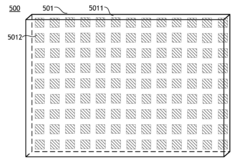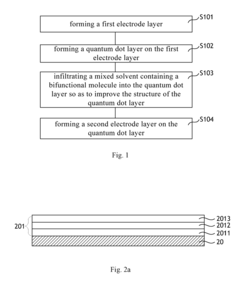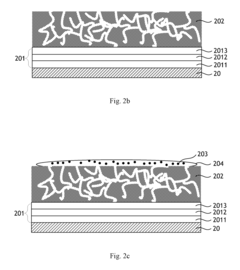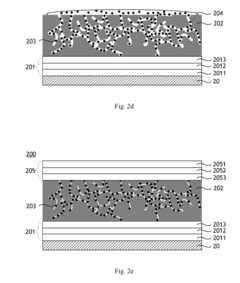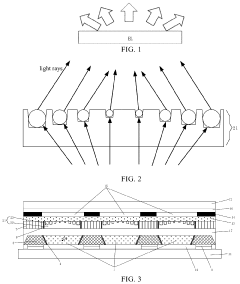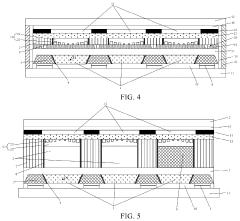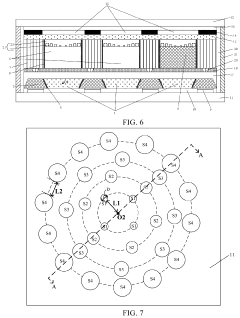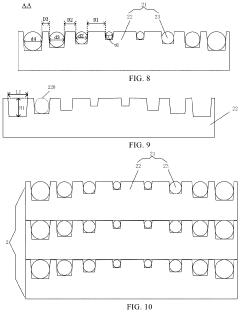Exploring the Global Market Growth for QLED Displays
JUN 20, 20259 MIN READ
Generate Your Research Report Instantly with AI Agent
Patsnap Eureka helps you evaluate technical feasibility & market potential.
QLED Display Evolution
QLED display technology has undergone significant evolution since its inception, marking key milestones in the advancement of display technology. The journey began with the development of quantum dots, nano-sized semiconductor particles that emit light when excited by electricity. These quantum dots were initially used to enhance the color performance of traditional LCD displays.
The first generation of QLED displays, introduced in the mid-2010s, utilized quantum dots in a film layer placed in front of the LED backlight. This configuration improved color accuracy and brightness compared to conventional LCD displays. However, these early QLEDs still relied on LCD technology for image formation.
As research progressed, the second generation of QLED displays emerged, featuring direct-emissive quantum dot technology. This breakthrough allowed quantum dots to emit light directly when stimulated by electric current, eliminating the need for a separate backlight and color filters. This advancement resulted in improved contrast ratios, wider viewing angles, and more energy-efficient displays.
The third generation of QLED displays focused on enhancing color purity and expanding the color gamut. Manufacturers developed quantum dots capable of producing more precise wavelengths of light, resulting in displays that could reproduce a wider range of colors with greater accuracy. This improvement was particularly noticeable in HDR content, where QLED displays could showcase more vibrant and lifelike images.
Recent developments in QLED technology have centered on improving pixel density and reducing power consumption. Researchers have made strides in creating smaller quantum dots and more efficient electron transport layers, enabling higher resolution displays with lower energy requirements. These advancements have paved the way for QLED technology to be applied in various form factors, from large-screen televisions to mobile devices.
The latest evolution in QLED displays involves the integration of artificial intelligence and machine learning algorithms. These smart features allow for real-time image processing, adaptive brightness control, and content-aware optimization, further enhancing the viewing experience and energy efficiency of QLED displays.
Looking ahead, the QLED display evolution is expected to continue with a focus on sustainability and flexibility. Researchers are exploring eco-friendly quantum dot materials and manufacturing processes to reduce the environmental impact of QLED production. Additionally, efforts are underway to develop flexible QLED displays that can be bent or folded, opening up new possibilities for innovative device designs and applications in various industries.
The first generation of QLED displays, introduced in the mid-2010s, utilized quantum dots in a film layer placed in front of the LED backlight. This configuration improved color accuracy and brightness compared to conventional LCD displays. However, these early QLEDs still relied on LCD technology for image formation.
As research progressed, the second generation of QLED displays emerged, featuring direct-emissive quantum dot technology. This breakthrough allowed quantum dots to emit light directly when stimulated by electric current, eliminating the need for a separate backlight and color filters. This advancement resulted in improved contrast ratios, wider viewing angles, and more energy-efficient displays.
The third generation of QLED displays focused on enhancing color purity and expanding the color gamut. Manufacturers developed quantum dots capable of producing more precise wavelengths of light, resulting in displays that could reproduce a wider range of colors with greater accuracy. This improvement was particularly noticeable in HDR content, where QLED displays could showcase more vibrant and lifelike images.
Recent developments in QLED technology have centered on improving pixel density and reducing power consumption. Researchers have made strides in creating smaller quantum dots and more efficient electron transport layers, enabling higher resolution displays with lower energy requirements. These advancements have paved the way for QLED technology to be applied in various form factors, from large-screen televisions to mobile devices.
The latest evolution in QLED displays involves the integration of artificial intelligence and machine learning algorithms. These smart features allow for real-time image processing, adaptive brightness control, and content-aware optimization, further enhancing the viewing experience and energy efficiency of QLED displays.
Looking ahead, the QLED display evolution is expected to continue with a focus on sustainability and flexibility. Researchers are exploring eco-friendly quantum dot materials and manufacturing processes to reduce the environmental impact of QLED production. Additionally, efforts are underway to develop flexible QLED displays that can be bent or folded, opening up new possibilities for innovative device designs and applications in various industries.
QLED Market Dynamics
The QLED display market has been experiencing significant growth and transformation in recent years, driven by technological advancements and changing consumer preferences. This dynamic sector is characterized by intense competition, rapid innovation, and evolving market demands.
The global QLED market has shown robust expansion, with a compound annual growth rate (CAGR) outpacing many other display technologies. This growth is primarily fueled by the increasing adoption of QLED displays in various applications, including televisions, monitors, and digital signage. The superior color performance, brightness, and energy efficiency of QLED technology have been key factors in its market success.
Consumer electronics, particularly the television segment, have been the primary driver of QLED market growth. Major manufacturers have been aggressively promoting QLED TVs as a premium alternative to OLED and traditional LED-LCD displays. The ability of QLED technology to deliver vibrant colors, high contrast ratios, and improved brightness levels has resonated well with consumers seeking enhanced viewing experiences.
The market dynamics are also influenced by regional variations in adoption rates. While North America and Europe have been early adopters of QLED technology, the Asia-Pacific region, particularly China, has emerged as a significant growth market. The increasing disposable income and growing demand for high-quality display products in these regions are contributing to the expansion of the QLED market.
Another factor shaping the QLED market dynamics is the ongoing competition with OLED technology. While OLED has been dominant in certain segments, particularly in smartphones and high-end TVs, QLED has been gaining ground due to its cost-effectiveness and improvements in picture quality. This competition has led to accelerated innovation and price reductions, benefiting consumers and driving market growth.
The commercial display sector has also been a significant contributor to QLED market dynamics. The technology's advantages in terms of brightness and durability make it well-suited for digital signage applications in retail, hospitality, and public spaces. This diversification of applications has helped to stabilize market demand and open new avenues for growth.
Supply chain considerations play a crucial role in QLED market dynamics. The availability and pricing of key components, such as quantum dots and display panels, can significantly impact market trends. Manufacturers are continuously working to optimize their supply chains and reduce production costs to maintain competitive pricing and meet market demand.
Looking ahead, the QLED market is expected to continue its growth trajectory, driven by technological improvements, expanding applications, and increasing consumer awareness. The ongoing development of next-generation QLED technologies, such as micro-LED and nano-LED, is likely to further shape market dynamics and competitive landscapes in the coming years.
The global QLED market has shown robust expansion, with a compound annual growth rate (CAGR) outpacing many other display technologies. This growth is primarily fueled by the increasing adoption of QLED displays in various applications, including televisions, monitors, and digital signage. The superior color performance, brightness, and energy efficiency of QLED technology have been key factors in its market success.
Consumer electronics, particularly the television segment, have been the primary driver of QLED market growth. Major manufacturers have been aggressively promoting QLED TVs as a premium alternative to OLED and traditional LED-LCD displays. The ability of QLED technology to deliver vibrant colors, high contrast ratios, and improved brightness levels has resonated well with consumers seeking enhanced viewing experiences.
The market dynamics are also influenced by regional variations in adoption rates. While North America and Europe have been early adopters of QLED technology, the Asia-Pacific region, particularly China, has emerged as a significant growth market. The increasing disposable income and growing demand for high-quality display products in these regions are contributing to the expansion of the QLED market.
Another factor shaping the QLED market dynamics is the ongoing competition with OLED technology. While OLED has been dominant in certain segments, particularly in smartphones and high-end TVs, QLED has been gaining ground due to its cost-effectiveness and improvements in picture quality. This competition has led to accelerated innovation and price reductions, benefiting consumers and driving market growth.
The commercial display sector has also been a significant contributor to QLED market dynamics. The technology's advantages in terms of brightness and durability make it well-suited for digital signage applications in retail, hospitality, and public spaces. This diversification of applications has helped to stabilize market demand and open new avenues for growth.
Supply chain considerations play a crucial role in QLED market dynamics. The availability and pricing of key components, such as quantum dots and display panels, can significantly impact market trends. Manufacturers are continuously working to optimize their supply chains and reduce production costs to maintain competitive pricing and meet market demand.
Looking ahead, the QLED market is expected to continue its growth trajectory, driven by technological improvements, expanding applications, and increasing consumer awareness. The ongoing development of next-generation QLED technologies, such as micro-LED and nano-LED, is likely to further shape market dynamics and competitive landscapes in the coming years.
QLED Tech Challenges
QLED (Quantum Dot Light Emitting Diode) display technology has made significant strides in recent years, offering enhanced color performance and energy efficiency compared to traditional LED displays. However, as with any emerging technology, QLED faces several technical challenges that need to be addressed to ensure its continued growth and adoption in the global market.
One of the primary challenges for QLED displays is the stability and longevity of quantum dots. These nanocrystals are susceptible to degradation when exposed to heat, moisture, and oxygen, which can lead to a decrease in display performance over time. Researchers are actively working on developing more robust quantum dot materials and improved encapsulation techniques to enhance the lifespan of QLED displays and maintain their superior color performance throughout the product's lifetime.
Another significant hurdle is the blue light emission in QLED displays. While red and green quantum dots have achieved high efficiency and stability, blue quantum dots lag behind in terms of performance. This imbalance affects the overall color accuracy and energy efficiency of QLED displays. Improving the efficiency and stability of blue quantum dots remains a critical area of focus for researchers and manufacturers in the QLED industry.
The manufacturing process for QLED displays also presents challenges, particularly in terms of scalability and cost-effectiveness. Current production methods for quantum dots and their integration into display panels are complex and expensive, which impacts the final product cost. Developing more efficient and economical manufacturing techniques is crucial for QLED technology to compete effectively with other display technologies in the mass market.
Color management and calibration pose another technical challenge for QLED displays. While quantum dots offer a wider color gamut, ensuring accurate and consistent color reproduction across different devices and viewing conditions requires sophisticated color management systems. This is particularly important for professional applications where color accuracy is critical, such as in graphic design and video production.
Heat management is an ongoing concern for QLED displays, especially in larger formats and high-brightness applications. The heat generated during operation can affect the performance and lifespan of quantum dots, potentially leading to color shift and reduced efficiency over time. Developing more effective thermal management solutions is essential to maintain the display's performance and reliability.
Lastly, the environmental impact of quantum dot production and disposal is a growing concern. Some quantum dot materials contain heavy metals or other potentially harmful substances. As QLED technology becomes more widespread, addressing these environmental concerns through the development of more eco-friendly quantum dot materials and sustainable manufacturing processes will be crucial for long-term market acceptance and regulatory compliance.
One of the primary challenges for QLED displays is the stability and longevity of quantum dots. These nanocrystals are susceptible to degradation when exposed to heat, moisture, and oxygen, which can lead to a decrease in display performance over time. Researchers are actively working on developing more robust quantum dot materials and improved encapsulation techniques to enhance the lifespan of QLED displays and maintain their superior color performance throughout the product's lifetime.
Another significant hurdle is the blue light emission in QLED displays. While red and green quantum dots have achieved high efficiency and stability, blue quantum dots lag behind in terms of performance. This imbalance affects the overall color accuracy and energy efficiency of QLED displays. Improving the efficiency and stability of blue quantum dots remains a critical area of focus for researchers and manufacturers in the QLED industry.
The manufacturing process for QLED displays also presents challenges, particularly in terms of scalability and cost-effectiveness. Current production methods for quantum dots and their integration into display panels are complex and expensive, which impacts the final product cost. Developing more efficient and economical manufacturing techniques is crucial for QLED technology to compete effectively with other display technologies in the mass market.
Color management and calibration pose another technical challenge for QLED displays. While quantum dots offer a wider color gamut, ensuring accurate and consistent color reproduction across different devices and viewing conditions requires sophisticated color management systems. This is particularly important for professional applications where color accuracy is critical, such as in graphic design and video production.
Heat management is an ongoing concern for QLED displays, especially in larger formats and high-brightness applications. The heat generated during operation can affect the performance and lifespan of quantum dots, potentially leading to color shift and reduced efficiency over time. Developing more effective thermal management solutions is essential to maintain the display's performance and reliability.
Lastly, the environmental impact of quantum dot production and disposal is a growing concern. Some quantum dot materials contain heavy metals or other potentially harmful substances. As QLED technology becomes more widespread, addressing these environmental concerns through the development of more eco-friendly quantum dot materials and sustainable manufacturing processes will be crucial for long-term market acceptance and regulatory compliance.
QLED Tech Solutions
01 QLED display technology advancements
Continuous improvements in QLED display technology, including enhanced color gamut, brightness, and energy efficiency, are driving market growth. These advancements are making QLED displays more attractive for various applications, from consumer electronics to professional displays.- QLED display technology advancements: Continuous improvements in QLED display technology, including enhanced color gamut, brightness, and energy efficiency, are driving market growth. These advancements are making QLED displays more attractive for various applications, from consumer electronics to professional displays.
- Market analysis and forecasting: Comprehensive market analysis and forecasting techniques are being employed to predict QLED display market growth. These methods consider factors such as consumer demand, technological advancements, and competitive landscape to provide accurate growth projections.
- Application expansion in various industries: QLED displays are finding new applications across various industries, including automotive, healthcare, and smart home devices. This expansion of use cases is contributing significantly to market growth and driving innovation in display technologies.
- Supply chain and manufacturing optimization: Efforts to optimize the supply chain and manufacturing processes for QLED displays are helping to reduce costs and increase production efficiency. These improvements are enabling manufacturers to meet growing demand and expand market share.
- Integration with emerging technologies: The integration of QLED displays with emerging technologies such as artificial intelligence, Internet of Things, and 5G is creating new growth opportunities. These synergies are enhancing the functionality and appeal of QLED displays in various applications.
02 Market analysis and forecasting
Comprehensive market analysis and forecasting techniques are being employed to predict QLED display market growth. These methods consider factors such as consumer demand, technological advancements, and competitive landscape to provide accurate growth projections.Expand Specific Solutions03 Application expansion in various industries
QLED displays are finding new applications across various industries, including automotive, healthcare, and smart home devices. This expansion of use cases is contributing significantly to market growth and driving innovation in display technologies.Expand Specific Solutions04 Manufacturing process improvements
Advancements in manufacturing processes for QLED displays, such as improved quantum dot synthesis and deposition techniques, are leading to higher production efficiency and lower costs. These improvements are making QLED displays more competitive in the market.Expand Specific Solutions05 Integration with emerging technologies
The integration of QLED displays with emerging technologies like artificial intelligence, Internet of Things, and 5G is creating new growth opportunities. This convergence is enabling smart display solutions and enhancing user experiences across various applications.Expand Specific Solutions
QLED Industry Leaders
The global QLED display market is experiencing rapid growth, driven by increasing demand for high-quality visual experiences in consumer electronics and commercial applications. The industry is in a phase of technological maturation and market expansion, with key players like BOE Technology Group, TCL China Star Optoelectronics, and Sharp Corp leading innovation. The market size is projected to grow significantly, fueled by advancements in quantum dot technology and rising adoption in premium TVs and monitors. Companies such as Huawei Technologies and NTT Docomo are also contributing to the ecosystem, indicating a broadening application range. The technology's maturity is evident in the diverse research efforts from institutions like the University of Electronic Science & Technology of China and McGill University, suggesting ongoing refinement and potential breakthroughs in QLED display technology.
BOE Technology Group Co., Ltd.
Technical Solution: BOE has developed advanced QLED display technology using quantum dot materials to enhance color gamut and brightness. Their QLED panels utilize a blue LED backlight combined with red and green quantum dots to produce highly saturated colors. BOE has also implemented quantum dot color filter technology to improve color purity and efficiency. Their QLED displays feature wide color gamut coverage exceeding 100% NTSC, high brightness up to 1500 nits, and long lifespans due to inorganic quantum dot materials.
Strengths: Wide color gamut, high brightness, and long lifespan. Weaknesses: Higher production costs compared to traditional LCD, potential for blue light leakage.
Shenzhen China Star Optoelectronics Semicon Display Tech Co.
Technical Solution: CSOT has developed a range of QLED display technologies, including their advanced T-QLED (True Quantum Dot LED) solution. This technology uses a quantum dot color conversion layer directly on top of blue micro-LED chips, eliminating the need for traditional color filters and improving overall efficiency. CSOT's QLED displays offer ultra-high contrast ratios, peak brightness exceeding 2000 nits, and color gamut coverage of over 110% NTSC. They have also implemented advanced local dimming technology with thousands of independently controlled zones for precise contrast control. CSOT's QLED panels feature high refresh rates up to 144Hz and low response times, making them suitable for both high-end TVs and gaming monitors.
Strengths: Excellent contrast and brightness, high color accuracy, energy-efficient design. Weaknesses: Complex manufacturing process, higher costs compared to traditional QLED.
QLED Core Patents
QLED device and manufacturing method thereof, QLED display panel and QLED display device
PatentActiveUS20180294414A1
Innovation
- A method involving the infiltration of a mixed solvent containing bifunctional molecules into the quantum dot layer to form bridges between loose quantum dots, improving the compactness and regularity of both the surface and internal structure, using a process that includes temperature adjustment, rotation, and annealing to enhance solubility and diffusion.
Display panel and producing method thereof, and display device
PatentPendingUS20240224736A1
Innovation
- A display panel design featuring light emitting units with scattering components, where scattering particles are arranged in a matrix with particle sizes and distances correlated to increase light output, and refractive indexes varying along the light exiting direction to converge light rays, combined with quantum-dot luminescent layers and color converting units for improved light emission.
QLED Supply Chain
The QLED supply chain plays a crucial role in the global market growth for QLED displays. This complex network involves multiple stages, from raw material sourcing to final product distribution, each contributing to the overall efficiency and competitiveness of QLED technology in the display market.
At the foundation of the QLED supply chain are the suppliers of key materials, including quantum dots, which are the core component of QLED technology. These specialized nanoparticles are typically produced by chemical companies or dedicated quantum dot manufacturers. The quality and consistency of these materials significantly impact the performance of QLED displays.
Panel manufacturers form the next critical link in the chain. They integrate quantum dots into display panels, combining them with other components such as backlight units, color filters, and thin-film transistors. This stage requires precision engineering and advanced manufacturing capabilities to ensure optimal color performance and energy efficiency.
Component suppliers provide essential elements such as drivers, power management systems, and optical films. These components are crucial for enhancing the overall performance and functionality of QLED displays. The innovation and quality of these supporting technologies can significantly influence the final product's competitiveness.
Assembly and integration partners play a vital role in bringing together all the components to create the finished QLED displays. This stage often involves collaboration between panel manufacturers and consumer electronics brands, particularly for larger display products like televisions.
Distribution networks and retail channels form the final link in the QLED supply chain. These entities are responsible for bringing QLED products to consumers and businesses worldwide. The effectiveness of these channels can greatly influence market penetration and consumer adoption rates.
The QLED supply chain is characterized by its global nature, with different stages often spread across multiple countries. This international distribution of production and expertise can lead to both opportunities and challenges, such as leveraging regional strengths and managing geopolitical risks.
Continuous innovation throughout the supply chain is essential for driving QLED market growth. This includes advancements in quantum dot synthesis, improvements in manufacturing processes, and the development of new applications for QLED technology beyond traditional display products.
At the foundation of the QLED supply chain are the suppliers of key materials, including quantum dots, which are the core component of QLED technology. These specialized nanoparticles are typically produced by chemical companies or dedicated quantum dot manufacturers. The quality and consistency of these materials significantly impact the performance of QLED displays.
Panel manufacturers form the next critical link in the chain. They integrate quantum dots into display panels, combining them with other components such as backlight units, color filters, and thin-film transistors. This stage requires precision engineering and advanced manufacturing capabilities to ensure optimal color performance and energy efficiency.
Component suppliers provide essential elements such as drivers, power management systems, and optical films. These components are crucial for enhancing the overall performance and functionality of QLED displays. The innovation and quality of these supporting technologies can significantly influence the final product's competitiveness.
Assembly and integration partners play a vital role in bringing together all the components to create the finished QLED displays. This stage often involves collaboration between panel manufacturers and consumer electronics brands, particularly for larger display products like televisions.
Distribution networks and retail channels form the final link in the QLED supply chain. These entities are responsible for bringing QLED products to consumers and businesses worldwide. The effectiveness of these channels can greatly influence market penetration and consumer adoption rates.
The QLED supply chain is characterized by its global nature, with different stages often spread across multiple countries. This international distribution of production and expertise can lead to both opportunities and challenges, such as leveraging regional strengths and managing geopolitical risks.
Continuous innovation throughout the supply chain is essential for driving QLED market growth. This includes advancements in quantum dot synthesis, improvements in manufacturing processes, and the development of new applications for QLED technology beyond traditional display products.
QLED Sustainability
QLED displays have made significant strides in sustainability, addressing environmental concerns associated with traditional display technologies. The manufacturing process of QLED panels has been optimized to reduce energy consumption and waste generation. Advanced production techniques have enabled manufacturers to minimize the use of rare earth elements, which are often associated with environmental degradation during extraction.
One of the key sustainability advantages of QLED technology lies in its energy efficiency. QLED displays consume less power compared to conventional LCD and OLED panels, particularly when displaying bright content. This energy efficiency translates to reduced carbon emissions over the lifetime of the device, aligning with global efforts to combat climate change.
The longevity of QLED displays also contributes to their sustainability profile. With improved resistance to burn-in and color degradation, QLED panels maintain their performance for extended periods, reducing the frequency of replacements and subsequently decreasing electronic waste. Furthermore, the materials used in QLED displays are increasingly being designed for easier recycling and recovery at the end of the product's life cycle.
Manufacturers are investing in circular economy initiatives for QLED displays. These programs focus on refurbishing and reusing components, as well as developing more efficient recycling processes for quantum dot materials. Such efforts not only reduce the environmental impact but also create opportunities for cost savings and resource conservation in the long term.
The packaging and transportation of QLED displays have also seen improvements in sustainability. Companies are adopting eco-friendly packaging materials and optimizing logistics to reduce the carbon footprint associated with product distribution. Additionally, the lightweight nature of QLED panels compared to some alternative technologies contributes to lower transportation-related emissions.
As consumer awareness of environmental issues grows, the sustainability features of QLED displays are becoming increasingly important in purchasing decisions. This trend is driving further innovation in sustainable manufacturing practices and product design within the QLED industry. Companies are now actively promoting the eco-friendly aspects of their QLED products as a key differentiator in the competitive display market.
Looking ahead, ongoing research is focused on developing even more sustainable QLED technologies. This includes exploring bio-based materials for quantum dots, improving the efficiency of blue QLED emitters, and enhancing the overall recyclability of display components. These advancements promise to further solidify QLED's position as a sustainable choice in the display technology landscape.
One of the key sustainability advantages of QLED technology lies in its energy efficiency. QLED displays consume less power compared to conventional LCD and OLED panels, particularly when displaying bright content. This energy efficiency translates to reduced carbon emissions over the lifetime of the device, aligning with global efforts to combat climate change.
The longevity of QLED displays also contributes to their sustainability profile. With improved resistance to burn-in and color degradation, QLED panels maintain their performance for extended periods, reducing the frequency of replacements and subsequently decreasing electronic waste. Furthermore, the materials used in QLED displays are increasingly being designed for easier recycling and recovery at the end of the product's life cycle.
Manufacturers are investing in circular economy initiatives for QLED displays. These programs focus on refurbishing and reusing components, as well as developing more efficient recycling processes for quantum dot materials. Such efforts not only reduce the environmental impact but also create opportunities for cost savings and resource conservation in the long term.
The packaging and transportation of QLED displays have also seen improvements in sustainability. Companies are adopting eco-friendly packaging materials and optimizing logistics to reduce the carbon footprint associated with product distribution. Additionally, the lightweight nature of QLED panels compared to some alternative technologies contributes to lower transportation-related emissions.
As consumer awareness of environmental issues grows, the sustainability features of QLED displays are becoming increasingly important in purchasing decisions. This trend is driving further innovation in sustainable manufacturing practices and product design within the QLED industry. Companies are now actively promoting the eco-friendly aspects of their QLED products as a key differentiator in the competitive display market.
Looking ahead, ongoing research is focused on developing even more sustainable QLED technologies. This includes exploring bio-based materials for quantum dots, improving the efficiency of blue QLED emitters, and enhancing the overall recyclability of display components. These advancements promise to further solidify QLED's position as a sustainable choice in the display technology landscape.
Unlock deeper insights with Patsnap Eureka Quick Research — get a full tech report to explore trends and direct your research. Try now!
Generate Your Research Report Instantly with AI Agent
Supercharge your innovation with Patsnap Eureka AI Agent Platform!
